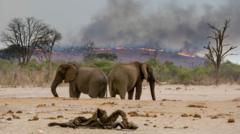As the battle against the California wildfires intensifies, evacuation orders and health warnings reflect a growing sense of urgency among residents.
California Wildfires Prompt Urgent Evacuations Amid Escalating Threats

California Wildfires Prompt Urgent Evacuations Amid Escalating Threats
Thousands are forced from their homes as devastating wildfires ravage parts of California, enhanced by powerful winds.
The fast-moving wildfire near Moorpark, California, is wreaking havoc and has led to thousands of evacuation orders issued for residents in the region. First reported on Wednesday morning, the blaze is fueled by heavy winds, creating a perilous situation for communities situated northwest of Los Angeles. California Governor Gavin Newsom confirmed that over 10,000 people have been urged to leave their homes, with around 3,500 structures, including homes, facing imminent danger.
Despite forecasts indicating a decrease in wind speeds by Thursday night, the National Weather Service has cautioned that the threat of wildfires persists. Dramatic aerial footage reveals extensive smoke clouds enveloping neighborhoods, a stark reminder of the escalating disaster. Ventura County fire chief Dustin Gardner described the situation on Wednesday as "dangerously fast," noting that everything—bushes, grass, agricultural fields, and structures—is being consumed by the flames.
Injuries have been reported; two individuals were treated for smoke inhalation, while firefighters, fortunately, have not encountered significant harm during their efforts. As the fire spreads, local authorities in several Southern California counties are advising residents to remain vigilant, as fast-spreading blazes, power outages, and downed trees become potential threats.
The City of Ventura has urged its residents to conserve water in order to ensure sufficient supplies for firefighting efforts. In addition, over 20 schools in Ventura County are set to close in response to the blaze on Thursday.
This wildfire ignited during a Santa Ana wind event, characterized by strong, dry winds colloquially known as "devil winds." Reports indicated gusts reaching as high as 80 mph, contributing to the rapid expansion of the fire, which surged from an initial area of just under 0.5 square miles to more than 16 square miles within a mere five-hour period.
California's history of wildfires underscores the urgency of the situation. Researchers indicate that the size of burned areas during summer in northern and central California has risen dramatically, attributed largely to human-induced climate change. However, they caution that not every fire can be directly linked to these causes, as land management practices play an essential role. Scientists emphasize that climate change exacerbates conditions favorable for wildfires, including drought and extreme temperatures.
Despite forecasts indicating a decrease in wind speeds by Thursday night, the National Weather Service has cautioned that the threat of wildfires persists. Dramatic aerial footage reveals extensive smoke clouds enveloping neighborhoods, a stark reminder of the escalating disaster. Ventura County fire chief Dustin Gardner described the situation on Wednesday as "dangerously fast," noting that everything—bushes, grass, agricultural fields, and structures—is being consumed by the flames.
Injuries have been reported; two individuals were treated for smoke inhalation, while firefighters, fortunately, have not encountered significant harm during their efforts. As the fire spreads, local authorities in several Southern California counties are advising residents to remain vigilant, as fast-spreading blazes, power outages, and downed trees become potential threats.
The City of Ventura has urged its residents to conserve water in order to ensure sufficient supplies for firefighting efforts. In addition, over 20 schools in Ventura County are set to close in response to the blaze on Thursday.
This wildfire ignited during a Santa Ana wind event, characterized by strong, dry winds colloquially known as "devil winds." Reports indicated gusts reaching as high as 80 mph, contributing to the rapid expansion of the fire, which surged from an initial area of just under 0.5 square miles to more than 16 square miles within a mere five-hour period.
California's history of wildfires underscores the urgency of the situation. Researchers indicate that the size of burned areas during summer in northern and central California has risen dramatically, attributed largely to human-induced climate change. However, they caution that not every fire can be directly linked to these causes, as land management practices play an essential role. Scientists emphasize that climate change exacerbates conditions favorable for wildfires, including drought and extreme temperatures.




















